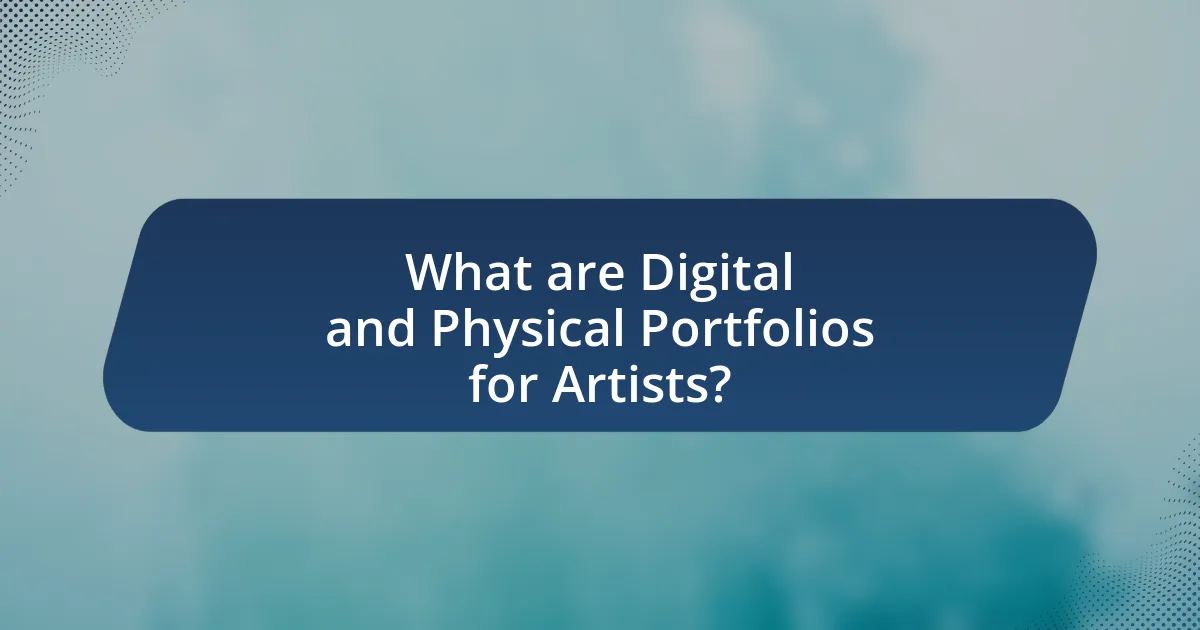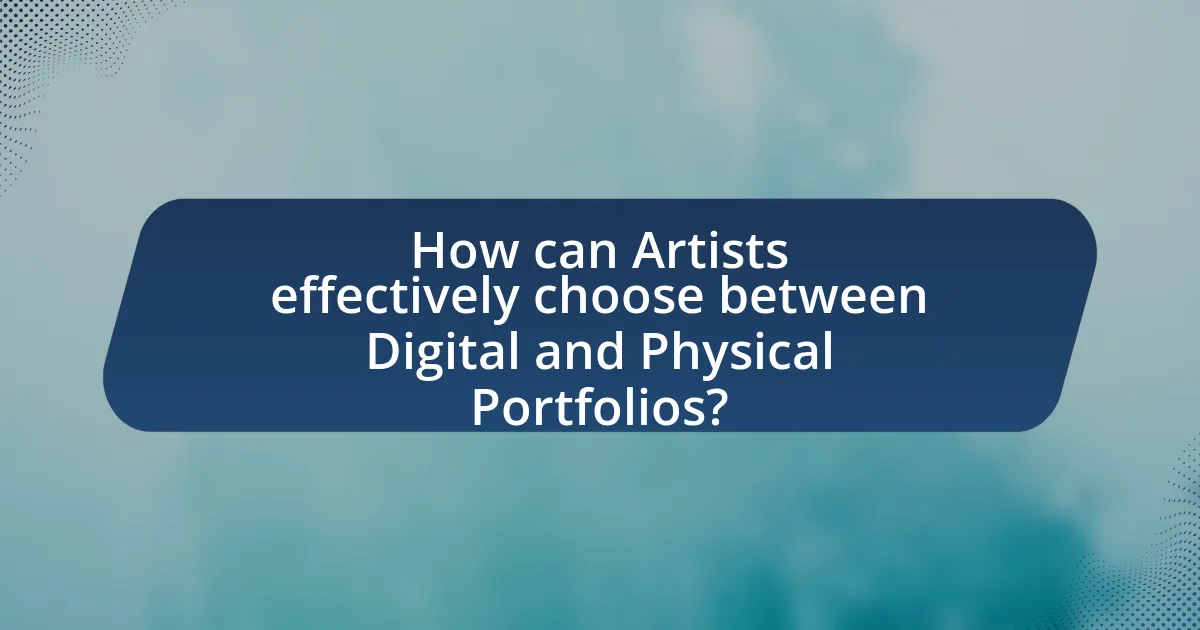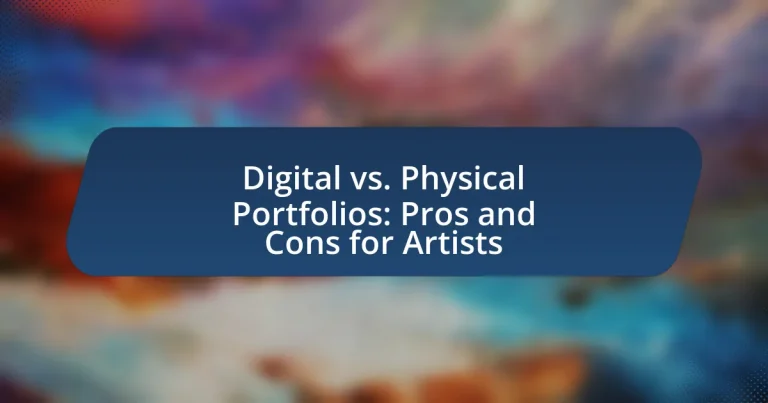Digital and physical portfolios are essential tools for artists to showcase their work, each offering distinct advantages and challenges. Digital portfolios provide broad accessibility, ease of sharing, and the ability to incorporate multimedia elements, making them ideal for reaching a global audience. In contrast, physical portfolios offer a tactile experience that enhances viewer engagement and allows for personal connections during in-person presentations. This article explores the differences between digital and physical portfolios, including their formats, materials, and the factors influencing an artist’s choice, while also addressing the advantages and drawbacks of each type. Key considerations include audience preferences, presentation styles, and the impact of an artist’s personal brand on portfolio selection.

What are Digital and Physical Portfolios for Artists?
Digital portfolios for artists are online collections of their work, typically hosted on websites or platforms that allow for easy sharing and accessibility. These portfolios enable artists to showcase their art to a global audience, often incorporating multimedia elements like videos and interactive features. In contrast, physical portfolios consist of tangible collections of artwork, such as printed images or original pieces, presented in binders or folders for in-person reviews. Physical portfolios allow for a tactile experience, which can be important in certain contexts, such as gallery exhibitions or interviews. Both types of portfolios serve the purpose of displaying an artist’s skills and style, but they cater to different audiences and situations, with digital portfolios offering broader reach and physical portfolios providing a personal touch.
How do Digital Portfolios differ from Physical Portfolios?
Digital portfolios differ from physical portfolios primarily in their format and accessibility. Digital portfolios are electronic collections of work that can be easily shared online, allowing for instant access and wider reach, while physical portfolios consist of tangible materials that require in-person presentation and are limited by physical space. The digital format enables artists to incorporate multimedia elements such as videos and interactive content, enhancing engagement, whereas physical portfolios are restricted to static images and printed materials. Additionally, digital portfolios can be updated in real-time, providing artists with the ability to showcase their latest work instantly, while physical portfolios necessitate manual updates and can become outdated quickly.
What formats are available for Digital Portfolios?
Digital portfolios are available in several formats, including websites, PDFs, videos, and presentations. Websites allow for interactive and easily updatable content, while PDFs provide a static, easily shareable document format. Videos can showcase dynamic work and presentations can be used for live or recorded showcases. Each format serves different purposes and can be tailored to the artist’s needs, enhancing the presentation of their work.
What materials are typically used in Physical Portfolios?
Physical portfolios typically use materials such as high-quality paper, cardstock, plastic sleeves, and binders. High-quality paper is essential for presenting artwork clearly, while cardstock provides durability and a professional appearance. Plastic sleeves protect individual pieces from damage and allow for easy organization, and binders offer a structured way to compile and present the portfolio. These materials are commonly chosen to ensure that the portfolio is both visually appealing and functional, meeting the standards expected in professional artistic presentations.
Why do Artists choose between Digital and Physical Portfolios?
Artists choose between digital and physical portfolios primarily based on accessibility and presentation preferences. Digital portfolios offer ease of sharing and the ability to reach a global audience instantly, while physical portfolios provide a tactile experience that can enhance the emotional impact of the artwork. The choice often reflects the artist’s target audience and the context in which they intend to showcase their work, as digital formats are increasingly favored in online platforms and social media, whereas physical portfolios are often preferred in face-to-face interactions, such as galleries or interviews.
What factors influence an artist’s choice of portfolio type?
An artist’s choice of portfolio type is influenced by factors such as audience reach, presentation style, and accessibility. Digital portfolios allow for broader audience reach through online platforms, while physical portfolios provide a tactile experience that can enhance the presentation of artwork. Additionally, the artist’s target market plays a crucial role; for instance, a contemporary artist may prefer digital formats to engage with a tech-savvy audience, whereas a traditional artist may opt for physical portfolios to showcase craftsmanship. Accessibility also matters; digital portfolios can be easily updated and shared, while physical portfolios require more effort to transport and display. These factors collectively guide artists in selecting the most effective portfolio type for their work and audience.
How does the target audience affect portfolio selection?
The target audience significantly influences portfolio selection by determining the type of work that resonates with potential clients or viewers. Artists must consider the preferences, demographics, and expectations of their audience to curate a portfolio that effectively showcases their skills and aligns with market demand. For instance, a portfolio aimed at commercial clients may prioritize polished, marketable pieces, while one targeting art collectors might emphasize unique, conceptual works. Research indicates that understanding audience preferences can lead to higher engagement and sales, as artists who tailor their portfolios to specific audiences often see improved outcomes in terms of commissions and exhibitions.
What are the key advantages of Digital Portfolios?
Digital portfolios offer several key advantages, including accessibility, ease of sharing, and the ability to showcase a diverse range of work. Accessibility allows users to view portfolios from any device with internet connectivity, making it convenient for both artists and potential clients. The ease of sharing enables artists to distribute their work quickly through various platforms, enhancing visibility and networking opportunities. Additionally, digital portfolios can incorporate multimedia elements such as videos and interactive content, providing a richer presentation of an artist’s skills and creativity. These advantages contribute to a more effective and engaging way for artists to present their work compared to traditional physical portfolios.
How does accessibility enhance the value of Digital Portfolios?
Accessibility enhances the value of digital portfolios by ensuring that a wider audience can engage with the content, regardless of their abilities or circumstances. This inclusivity not only broadens the potential reach of an artist’s work but also aligns with legal standards such as the Americans with Disabilities Act, which mandates accessible digital content. Research indicates that accessible digital portfolios can lead to increased user engagement and satisfaction, as they cater to diverse needs, including those of individuals with visual, auditory, or cognitive impairments. By prioritizing accessibility, artists can demonstrate social responsibility and enhance their professional reputation, ultimately leading to greater opportunities in the art community.
What role does multimedia play in Digital Portfolios?
Multimedia enhances digital portfolios by providing diverse formats such as images, videos, audio, and interactive elements that showcase an artist’s work more effectively. This variety allows artists to present their skills and creativity in a dynamic way, engaging viewers and making their portfolios more memorable. Research indicates that incorporating multimedia can increase user engagement by up to 80%, as it caters to different learning styles and preferences, thereby improving the overall impact of the portfolio.
What are the potential drawbacks of Digital Portfolios?
Digital portfolios can present several potential drawbacks, including issues related to accessibility, technical difficulties, and the risk of data loss. Accessibility can be a concern, as not all users may have reliable internet access or the necessary devices to view digital content. Technical difficulties, such as software compatibility or platform changes, can hinder the usability of digital portfolios. Additionally, the risk of data loss due to hardware failure or cyber threats poses a significant challenge, as artists may lose valuable work if proper backups are not maintained. These drawbacks highlight the importance of considering both the advantages and limitations of digital portfolios in the context of artistic presentation.
How can technical issues impact the effectiveness of Digital Portfolios?
Technical issues can significantly hinder the effectiveness of digital portfolios by disrupting access, functionality, and user experience. For instance, if a digital portfolio experiences server downtime, potential employers or clients may be unable to view the work, leading to missed opportunities. Additionally, compatibility issues across different devices and browsers can result in improper display of content, which detracts from the intended presentation of an artist’s work. Research indicates that 47% of users expect a web page to load in two seconds or less, and delays can lead to increased bounce rates, further emphasizing the importance of technical reliability in maintaining audience engagement.
What are the concerns regarding online privacy and security for Digital Portfolios?
Concerns regarding online privacy and security for digital portfolios include data breaches, unauthorized access, and identity theft. Digital portfolios often contain sensitive personal information, such as contact details and creative works, which can be targeted by cybercriminals. According to a 2021 report by Cybersecurity Ventures, cybercrime is projected to cost the world $10.5 trillion annually by 2025, highlighting the increasing risks associated with online data storage. Additionally, many platforms hosting digital portfolios may not implement robust security measures, leaving users vulnerable to hacking and exploitation.

What are the advantages of Physical Portfolios?
Physical portfolios offer tangible representation of an artist’s work, allowing for direct interaction and a more personal connection with the audience. This physicality can enhance the viewer’s experience, as they can appreciate the texture, color, and details of the artwork in a way that digital formats may not fully convey. Additionally, physical portfolios can create a stronger impact during in-person presentations, as they allow artists to showcase their work in a curated manner, facilitating discussions and immediate feedback. The ability to control the presentation environment further enhances the artist’s narrative, making it easier to convey the context and intention behind each piece.
How do Physical Portfolios create a tangible experience for viewers?
Physical portfolios create a tangible experience for viewers by allowing them to physically interact with the artwork, enhancing sensory engagement. This interaction fosters a deeper emotional connection, as viewers can touch, feel, and closely examine the materials and textures used in the pieces. Research indicates that tactile experiences can significantly influence perception and appreciation of art, as evidenced by studies showing that physical interaction with objects can enhance memory retention and emotional responses. Thus, the physicality of portfolios not only showcases the artist’s work but also enriches the viewer’s overall experience through direct sensory involvement.
What impact does the quality of materials have on viewer perception?
The quality of materials significantly influences viewer perception by affecting the perceived value and professionalism of the artwork. High-quality materials often convey a sense of care and attention to detail, leading viewers to appreciate the work more deeply. For instance, research indicates that artworks presented on premium canvases or with archival inks are often rated higher in terms of aesthetic appeal and emotional impact compared to those made with inferior materials. This correlation suggests that viewers associate the quality of materials with the artist’s skill and commitment, ultimately shaping their overall experience and interpretation of the artwork.
How can Physical Portfolios enhance networking opportunities?
Physical portfolios enhance networking opportunities by providing tangible, visual representations of an artist’s work that can be shared in face-to-face interactions. When artists present physical portfolios at events, they create memorable experiences that facilitate deeper conversations and connections with potential collaborators, clients, or industry professionals. Research indicates that personal interactions, supported by physical artifacts, significantly increase the likelihood of forming professional relationships, as they evoke emotional responses and foster trust. This is particularly relevant in creative fields, where the sensory experience of viewing art in person can leave a lasting impression, thereby enhancing networking effectiveness.
What challenges do Physical Portfolios present?
Physical portfolios present several challenges, including limited accessibility, difficulty in updating content, and potential for physical damage. Accessibility is restricted as physical portfolios can only be viewed in person, making it challenging to share with a wider audience. Updating content requires reprinting or physically altering the portfolio, which can be time-consuming and costly. Additionally, physical portfolios are susceptible to damage from environmental factors such as moisture or light, which can degrade the quality of the work presented. These challenges highlight the limitations of physical portfolios compared to their digital counterparts.
How does portability affect the use of Physical Portfolios?
Portability significantly limits the use of physical portfolios, as they are often bulky and cumbersome to transport. Artists may find it challenging to carry physical portfolios to meetings, exhibitions, or interviews, which can hinder their ability to showcase their work effectively. For instance, a study by the National Endowment for the Arts indicates that artists who utilize digital portfolios can easily share their work across various platforms, enhancing accessibility and reach. In contrast, the physical nature of traditional portfolios restricts spontaneous opportunities for presentation, ultimately affecting an artist’s ability to network and gain exposure.
What are the costs associated with maintaining a Physical Portfolio?
The costs associated with maintaining a physical portfolio include printing, binding, storage, and transportation expenses. Printing high-quality images can range from $1 to $5 per print, depending on size and material. Binding costs for portfolios can vary from $20 to $100, depending on the type of binding chosen. Additionally, artists must consider storage costs, which can include renting space or purchasing materials to protect the portfolio, often amounting to $50 to $200 annually. Transportation costs, especially for traveling to exhibitions or meetings, can add further expenses, including shipping fees or travel costs, which can vary widely based on distance and method of transport.

How can Artists effectively choose between Digital and Physical Portfolios?
Artists can effectively choose between digital and physical portfolios by assessing their target audience, the nature of their work, and the context in which they will present their portfolios. Digital portfolios offer advantages such as easy sharing, accessibility, and the ability to showcase multimedia content, making them ideal for reaching a broader audience online. In contrast, physical portfolios provide a tactile experience and can create a stronger personal connection during in-person meetings or exhibitions, which is beneficial for certain artistic fields.
Research indicates that 70% of art professionals prefer digital portfolios for initial reviews due to convenience, while 60% value physical portfolios for final presentations (Art Business Journal, 2022). Therefore, artists should consider these factors and statistics to make an informed decision that aligns with their artistic goals and audience preferences.
What criteria should artists consider when selecting a portfolio type?
Artists should consider the intended audience and purpose of their portfolio when selecting a portfolio type. For instance, digital portfolios offer accessibility and ease of sharing, making them suitable for reaching a broader audience online. Conversely, physical portfolios can provide a tactile experience, which may be more impactful in face-to-face settings, such as galleries or interviews. Additionally, artists should evaluate the nature of their work; for example, visual artists may benefit from high-quality prints in a physical portfolio, while graphic designers might prefer the versatility of a digital format. Ultimately, the choice between digital and physical portfolios should align with the artist’s goals, the medium of their work, and the preferences of their target audience.
How can an artist’s personal brand influence their portfolio choice?
An artist’s personal brand significantly influences their portfolio choice by shaping the type of work they showcase to align with their identity and audience expectations. For instance, an artist known for vibrant, contemporary styles may choose a digital portfolio to reach a broader, tech-savvy audience, while an artist with a classic, traditional brand might prefer a physical portfolio to convey authenticity and craftsmanship. This alignment is crucial, as research indicates that 70% of consumers are more likely to engage with brands that reflect their personal values and aesthetics, highlighting the importance of consistency between an artist’s brand and their portfolio presentation.
What role does the intended use of the portfolio play in the decision-making process?
The intended use of the portfolio significantly influences the decision-making process by determining the format, content, and presentation style that best aligns with the artist’s goals. For instance, artists aiming to showcase their work to potential clients or galleries may prefer a digital portfolio for its accessibility and ease of sharing, while those seeking to create a tactile experience may opt for a physical portfolio. Research indicates that 70% of art professionals prefer digital portfolios for their convenience and ability to include multimedia elements, which can enhance the artist’s narrative and engagement. Thus, the intended use directly shapes the strategic choices artists make regarding their portfolios, ensuring they effectively communicate their artistic vision and meet the expectations of their target audience.
What best practices can artists follow when creating their portfolios?
Artists should focus on showcasing their best work, maintaining a cohesive theme, and ensuring high-quality presentation when creating their portfolios. A well-curated selection of pieces highlights an artist’s skills and style, making it easier for viewers to understand their artistic identity. Consistency in theme across the portfolio helps to create a strong narrative, while high-quality images and professional layouts enhance visual appeal. Research indicates that portfolios with a clear focus and professional presentation are more likely to attract attention from galleries and clients, as they reflect an artist’s professionalism and dedication to their craft.
How can artists effectively showcase their work in both Digital and Physical formats?
Artists can effectively showcase their work in both digital and physical formats by utilizing a multi-platform approach that combines online portfolios, social media, and physical exhibitions. Online portfolios allow artists to reach a global audience, while social media platforms like Instagram and Pinterest enable real-time engagement and sharing of their work. Physical exhibitions, such as gallery shows or art fairs, provide tangible experiences that can create deeper connections with viewers.
Research indicates that artists who maintain both digital and physical presences can increase their visibility and sales opportunities. For instance, a study by the National Endowment for the Arts found that artists who engage with audiences through multiple channels are more likely to attract diverse clientele and enhance their marketability. This dual strategy not only broadens their reach but also caters to different audience preferences, ensuring that their work is accessible in various contexts.
What common mistakes should artists avoid when developing their portfolios?
Artists should avoid including too many pieces in their portfolios, as this can dilute the impact of their best work. A focused selection of high-quality pieces demonstrates skill and vision more effectively than a large quantity of mediocre work. Additionally, artists often make the mistake of neglecting to tailor their portfolios to specific audiences or opportunities, which can lead to missed chances for engagement. Another common error is failing to update portfolios regularly, resulting in outdated representations of their current style and capabilities. Lastly, artists should avoid poor presentation, as a cluttered or unprofessional layout can detract from the artwork itself.





